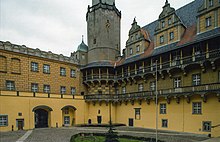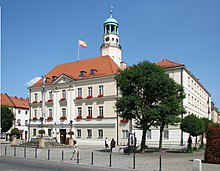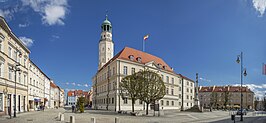Oleśnica
Oleśnica | |
|---|---|
| |
| Motto(s): Miasto wież i róż "A Town of Towers and Roses" | |
| Coordinates: 51°12′N 17°23′E / 51.200°N 17.383°E | |
| Country | |
| Voivodeship | |
| County | Oleśnica |
| Gmina | Oleśnica (urban gmina) |
| First mentioned | 1189 |
| Town rights | 1255 |
| Government | |
| • Mayor | Jan Bronś |
| Area | |
• Total | 20.96 km2 (8.09 sq mi) |
| Elevation | 150 m (490 ft) |
| Population (2019-06-30[1]) | |
• Total | 37,169 |
| • Density | 1,800/km2 (4,600/sq mi) |
| Time zone | UTC+1 (CET) |
| • Summer (DST) | UTC+2 (CEST) |
| Postal code | 56-400 |
| Area code | +48 71 |
| Car plates | DOL |
| Highways | |
| Voivodeship roads | |
| Website | http://www.olesnica.pl |
Oleśnica (Polish: [ɔlɛˈɕɲit͡sa]; German: Oels; Silesian: Ôleśnica) is a town in Lower Silesian Voivodeship, in south-western Poland, within the Wrocław metropolitan area. It is the administrative seat of Oleśnica County and also of the rural district of Gmina Oleśnica, although it is not part of the territory of the latter, the town being an urban gmina in its own right.
The town is famed for its large 16th-century castle, which has previously been the seat of several dukes and lords. The castle's inner courtyard arcades, a masterpiece of Renaissance architecture, are iconic in the region.
Name
[edit]The town's name comes from Polish olsza ("Alder"); Olcha is an Old Slavic word for this common plant and tree.[2][3] On 22 February 1255 the Silesian duke Henry III the White, son of the Polish High Duke Henry II the Pious, vested civitas nostra Olsnicz ("our town Oleśnica") with town privileges.[4]
Geography
[edit]The town is situated in the Silesian Lowlands east of the Trzebnickie Hills, part of the historical region of Lower Silesia. It is situated on the Oleśnica River, a tributary of Widawa. Located about 30 kilometres (19 mi) northeast of the Silesian capital Wrocław, it has been a stop on an important trade route to the Greater Poland region, Kalisz, Łódź and Warsaw; it had close ties with Kraków via Namysłów in the east.[citation needed] It was the site of an important printing press and gymnasium.
The town quarters are Centrum, Serbinów, Lucień, Lucień Osiedle, Wądoły, Rataje (Stare, Nowe) and Zielone Ogrody.
History
[edit]
The Piast castle with a nearby abbey and trading settlement was first mentioned in an 1189 deed. It was part of fragmented Poland under the Piast dynasty. In 1255, it was granted town rights by Duke Henry III the White. From the 13th century onwards, the area was largely settled by Germans in the course of the Ostsiedlung.[5] From the 13th century, it had a coin mint. In the 13th century Oleśnica was part of the Duchy of Silesia, in 1294 it became part of the Duchy of Głogów[6] and in 1313 it became capital of the Duchy of Oleśnica, just partitioned from Głogów. By that time a hospital already existed in Oleśnica, mentioned in a document from 1307.[6] From 1320/21 the former castellany served as the residence of the Piast duke Konrad I of Oleśnica; his son Duke Konrad II the Gray also inherited Koźle. The dukes of Oleśnica in the 14th century still claimed to be heirs of the entire Kingdom of Poland, even though they ruled only in their principality, which caused animosity from other Polish dukes in Silesia and monarchs of all Poland.[6] Oleśnica was located on an important trade route which connected Wrocław with Kalisz and Toruń.[6]
In 1329, Duke Konrad I was forced to accept the overlordship of the Bohemian (Czech) Crown, although he retained vast autonomy.[6] Local Polish dukes granted numerous privileges to Oleśnica,[6] and the Duchy of Oleśnica was still ruled from the town until the 1492 death of Duke Konrad X the White, last of the local Piasts. During the Hussite Wars, Oleśnica was invaded by the Hussites in 1432, and later Polish–Hussite negotiations took place there.[6] During the Bohemian–Hungarian War local dukes switched sides several times. In 1469 they recognized the overlordship of King Matthias Corvinus of Hungary, in the 1470s Duke Konrad X sided with Bohemian King Vladislaus Jagiellon, in 1480 he recognized Hungarian suzerainty again, and then revolted in 1489.[6] Afterwards it was again a Bohemian fief.

According to an agreement from 1491, the duchy was supposed to pass to future Polish King John I Albert, but eventually in 1495 it was sold to Duke Henry I of Münsterberg, son of the Bohemian (Czech) king George of Poděbrady.[6] His grandson Duke John of Münsterberg-Oels established a gymnasium at Oleśnica in 1530. When the Czech Podiebrad family became extinct in 1647, town and duchy were inherited by the Swabian dukes of Württemberg, and in 1792 by the Welf dukes of Brunswick-Lüneburg.
On September 11, 1535, a violent F4 tornado completely destroyed part of the town. The written account of this tornado was done by Dr. Alfred Wegener, which is in the CLIMDAT archive located at Leipzig University and the F4 rating on the Fujita scale was assigned by the European Severe Storms Laboratory.[7][8]
In the 17th century, the Polish-German language border ran close to Oleśnica, including the town to the territory dominated by the Polish language.[9] Polish religious writers Adam Gdacius (nicknamed Rey of Silesia) and Jerzy Bock published their works in Oleśnica.[10]


In the 18th century, one of two main routes connecting Warsaw and Dresden ran through the town and Kings Augustus II the Strong and Augustus III of Poland often traveled that route.[11] As a result of the First Silesian War the Duchy of Oels (Oleśnica) came under suzerainty of the Kingdom of Prussia in 1742. Following administrative reform in 1807 during the Napoleonic Wars, Oels became the seat of Landkreis Oels in the Province of Silesia, remaining capital of the Duchy of Oels (Oleśnica). In 1884 the duchy was incorporated into Prussia, itself part of Germany since the 1871 Prussian-led unification of Germany.
After World War I, Oels was included within the Province of Lower Silesia. Nazi Germany operated a prison in the town,[12] and a forced labour camp for Italian, English, Yugoslavian, Belgian and Polish prisoners of war during World War II.[13] Dozens of Polish resistance members, including women, were held in the local prison, and at least 14 were sentenced to death in the town in 1942.[14] The German administration evacuated almost the entire population, leaving only a few Germans and the forced laborers. The town was heavily damaged by the Red Army in 1945 in the final stages of World War II, having approximately 60-80% of its buildings destroyed. The city was became again part of Poland after the Potsdam Conference under its historic Polish name Oleśnica. The remaining German-speaking population was subsequently expelled in accordance to the Potsdam Agreement and the town was resettled with Poles many of whom were expelled from former eastern Poland annexed in 1945 by the Soviet Union. Some 3,000 Italians remained in the town until the end of 1945, and organized artistic shows to which they invited young Polish activists.[15] The majority of monuments in the Old Town have been rebuilt since the 1960s.
Cuisine
[edit]The officially protected traditional food of Oleśnica, as designated by the Ministry of Agriculture and Rural Development of Poland, is the Oleśnica wheat and rye gingerbread.[16]
Sports
[edit]Football club Pogoń Oleśnica is based in the town. It played at the Polish second division in the 1990s.
Notable people
[edit]
- Joachim of Münsterberg-Oels (1503–1562), Duke of Münsterberg and from 1536 to 1542 also Duke of Oels
- Hedwig of Münsterberg-Oels (1508–1531), Margravine of Brandenburg-Ansbach-Kulmbach
- John, Duke of Münsterberg-Oels (1509–1565), Duke of the Münsterberg from 1542 to 1565, Duke of Oels from 1548 to 1565 and Duke of Bernstadt from 1548 to 1565
- George II, Duke of Münsterberg-Oels (1512–1553), Duke of Münsterberg from 1536 to 1542 and Duke of Oels
- Henry III, Duke of Münsterberg-Oels (1542–1587), Duke of Münsterberg from 1565 to 1574 and Duke of Bernstadt
- Karl II, Duke of Münsterberg-Oels (1545–1617), Duke of Oels from 1565 to 1617 and Duke of Bernstadt from 1604 to 1617
- Karl Christoph, Duke of Münsterberg (1545–1569), Duke of Münsterberg from 1565 to 1569
- Henry Wenceslaus, Duke of Oels-Bernstadt (1592–1639)
- Abraham von Franckenberg (1593–1652), mystic, born in nearby Bystre
- Karl Friedrich I, Duke of Münsterberg-Oels (1593–1647), Duke of Oels from 1617 to 1647 and Duke of Bernstadt from 1639 to 1647
- Elisabeth Marie, Duchess of Oels (1625–1686), German noblewoman
- Christian Ulrich I, Duke of Württemberg-Oels (1652–1704), German nobleman, Duke of Württemberg-Bernstadt from 1669 to 1697 and Duke of Oels-Württemberg from 1697 until his death
- Julius Siegmund, Duke of Württemberg-Juliusburg (1653–1684), was Duke of Württemberg-Juliusburg
- Eugen of Württemberg (1788–1857), general
- Carl Heinrich Zöllner (1792–1836), German composer
- Julius Hübner (1806–1882), painter
- Gustav Becker (1819–1885), clockmaker
- Willy Hellpach (1877–1955), physicist and politician
- Antoni Cieszyński (1882–1941), surgeon
- Werner Krolikowski (born 1928), East German politician
- Sigmar Polke (1941–2010), artist
- Piotr Czech (born 1986), kicker for Pittsburgh Steelers
- Wojciech Bartnik (born 1967), boxer, Olympic bronze medallist
- Kasia Glowicka (born 1977), composer
- Jerzy Rogalski (born 1948), film and theatre actor
- Rafał Dębski (born 1969), Polish writer
- Babatunde Aiyegbusi (born 1989), Polish-Nigerian professional wrestler and former American football player
Twin towns – sister cities
[edit] Chrudim, Czech Republic
Chrudim, Czech Republic Jaunay-Marigny, France
Jaunay-Marigny, France Warendorf, Germany
Warendorf, Germany
Gallery
[edit]-
Saint John the Evangelist Basilica
-
A timber-framed house and the Holy Trinity Church
-
Holy Virgin Mary Church
-
Main post office
-
Former Officers' Mess
-
District court
-
Elementary school no. 7
-
Liceum Ogólnokształcące no. 2 (high school)
-
The Polish Veteran's Memorial
-
Polish Second Army Memorial
-
Old townhouses at the Market Square
-
Manhole cover with the Oleśnica coat of arms
References
[edit]- ^ "Population. Size and structure and vital statistics in Poland by territorial division in 2019. As of 30th June". stat.gov.pl. Statistics Poland. 2019-10-15. Retrieved 2020-02-14.
- ^ www.poradniajezykowa.us.edu.pl
- ^ www.olesnica.pl
- ^ http://alo.uibk.ac.at/webinterface/library/ALO-BOOK_V01?objid=19012[permanent dead link] page 333
- ^ Eberl, Immo (1993). Immo Eberl (ed.). Flucht, Vertreibung, Eingliederung (in German). Thorbecke. p. 26. ISBN 3-7995-2500-9.
- ^ a b c d e f g h i "Oleśnica w czasach książąt piastowskich". Konflikty.pl (in Polish). Retrieved 10 September 2020.
- ^ "European Severe Weather Database". European Severe Storms Laboratory. 2022. Retrieved May 5, 2022.
- ^ Kühne, Thilo. "[Tornado] 11.09.1535 - Oels / Oleśnica (DOL|PL)". Skywarn Deutschland. Thilo Kühne. Retrieved 4 September 2022.
- ^ Dorota Borowicz, Mapy narodowościowe Górnego Śląska od połowy XIX wieku do II Wojny Światowej, Wydawnictwo Uniwersytetu Wrocławskiego, Wrocław, 2004, p. 33
- ^ Wincenty Ogrodziński, Nauka domowa i wyjątki z Agendy, „Biblioteka pisarzy śląskich”, Katowice, 1936
- ^ "Informacja historyczna". Dresden-Warszawa (in Polish). Retrieved 10 September 2020.
- ^ "Gefängnis Oels". Bundesarchiv.de (in German). Retrieved 10 September 2020.
- ^ Sula, Dorota (2010). "Jeńcy włoscy na Dolnym Śląsku w czasie II wojny światowej". Łambinowicki rocznik muzealny (in Polish). 33. Opole: 68.
- ^ Encyklopedia konspiracji Wielkopolskiej 1939–1945 (in Polish). Poznań: Instytut Zachodni. 1998. pp. 137, 182, 228, 235, 294, 392, 408, 430, 462, 484, 488, 495, 514–515, 517–518, 522, 582, 655, 677, 682–683, 686, 694, 696–697, 700, 704–705, 709, 712–713, 716, 720–722, 725–726, 732–735, 737–743, 746, 748, 755, 757. ISBN 83-85003-97-5.
- ^ Sula, p. 69
- ^ "Pszenno-żytnie pierniki z Oleśnicy". Ministerstwo Rolnictwa i Rozwoju Wsi - Portal Gov.pl (in Polish). Retrieved 25 November 2023.
- ^ "Miasta partnerskie". olesnica.pl (in Polish). Oleśnica. Retrieved 2020-02-03.
External links
[edit]- Municipal website
- Panorama Oleśnicka (in Polish)
- News from Oleśnica (in Polish)
- History of Oleśnica (in Polish)
- Old postcards from Oleśnica (in Polish)
- Jewish Community in Oleśnica on Virtual Shtetl






















